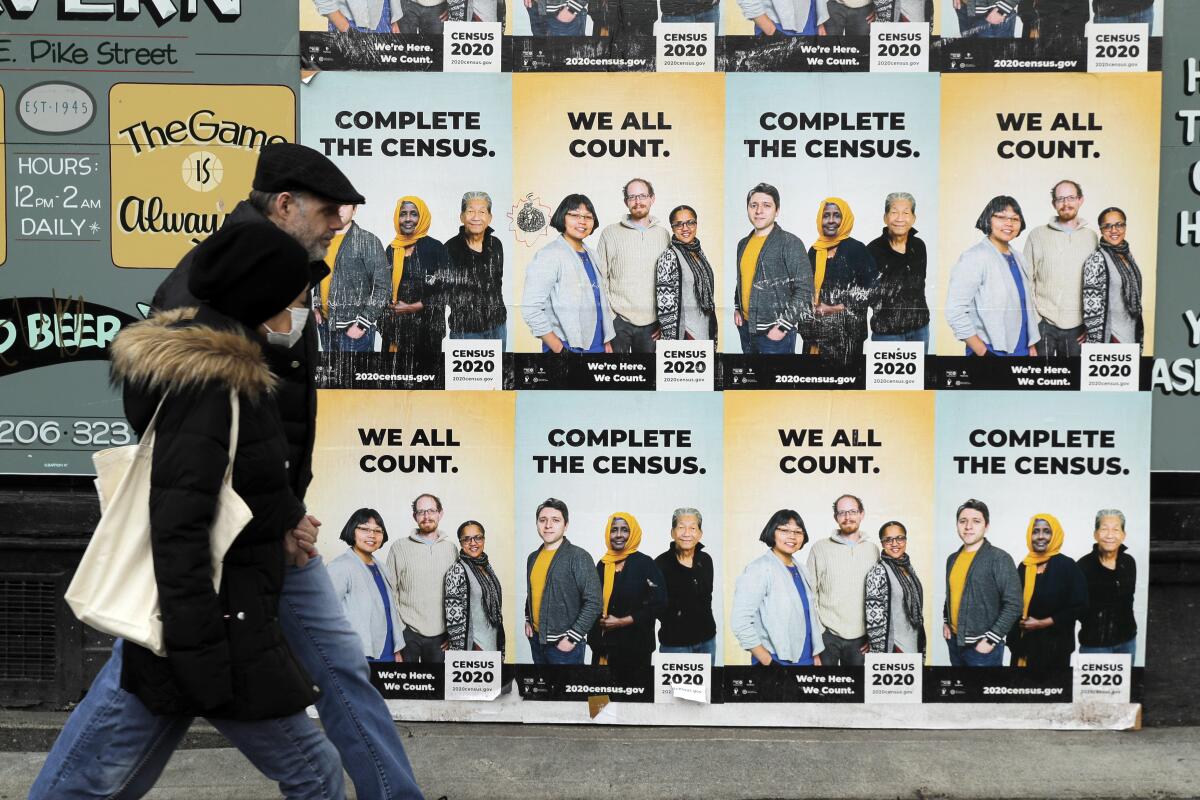Editorial: Let us count the ways Trump has damaged the 2020 census

- Share via
Ready or not, the federal government wrapped up its count for the 2020 census early Friday. And sadly, it wasn’t ready.
Much as he has done to other governmental institutions, President Trump has swung a wrecking ball through the census. In his zeal to use the decennial headcount to hurt Democrats and help Republicans in future elections, Trump has destabilized a process that determines how many seats in Congress each state will have, as well as guiding how congressional and state legislative districts will be drawn.
To be sure, the census has never been immune to political interference. “The American Census: A Social History,” by University of Wisconsin Milwaukee historian Margo J. Anderson details some of the fracases over the years caused by the end of slavery, the influx of immigrants and other demographic shifts, and disproportionate undercounts of racial and ethnic minorities.
But what Trump is doing this cycle is stunning in its cynicism. Two years ago the administration sought to add a question to the census about citizenship status, ostensibly to help the Justice Department enforce the Voting Rights Act. That was a ginned-up argument to cover the real purpose: to dampen participation in the census by immigrant-heavy communities that historically have aligned with the Democratic Party. The Supreme Court rejected the government’s rationale and ordered that the question be dropped, but Trump followed up by directing agencies to help the Commerce Department determine the citizenship status of immigrants so it could subtract those numbers from the census totals.
Political mailers specialize in borderline truths and gross exaggerations. But slate mailers may be the worst of the bunch.
That, too, is under legal challenge, and rightly so. The Constitution clearly states that the census must count residents, not citizens, and that seats in the House must be divided “among the several States according to their respective numbers, counting the whole number of persons in each State.” As a practical matter, to exclude noncitizens from the reapportionment count would skew the makeup of the House, leaving states with higher numbers of immigrants (like California) with fewer representatives. The Pew Research Center estimates about 22.8 million immigrants — including those living here legally — are not U.S. citizens. That’s roughly 7% of the people living in the country.
The COVID-19 pandemic has made just about everything more difficult, and earlier this year the Trump administration told Congress that it needed more time and money to ensure an accurate count. The Commerce Department also said it could not report the state-by-state population counts to the president by the end of the year, as the law requires, but would need until the end of April 2021. That report tells the House how many seats each state is entitled to; notably, the government also uses the census data to decide how to distribute as much as $1.5 trillion a year in federal funds.
But Commerce Secretary Wilbur Ross reversed course in August and announced, over the objection of census experts, that the count deadline would be moved up to Sept. 30 so the Census Bureau could start processing the data (and taking reckless shortcuts, critics say) to meet the Dec. 31 reporting deadline. After the National Urban League and other advocacy groups sued, lower courts ordered that the count continue through October. On Tuesday, however, the U.S. Supreme Court decided that the Commerce Department could end the count now in order to finish processing the numbers by Dec. 31.
Had Congress granted the administration’s initial request to extend the reporting deadline to April 30, that could have left the decision on how many House seats each state gets to a President Biden should Trump lose his reelection bid. Hence the reversal by Ross and the appeal to the Supreme Court to stop the count. Barring more court action, the reapportionment of seats will be done by the Trump administration.
L.A.’s most injured neighborhoods need exactly what they needed 30 years ago and did not get, including a more responsive, more respectful police force.
Meanwhile, the administration has been pushing an all-is-well message about the census, including claiming that it has counted 99.9% of U.S. households. Critics, though, argue persuasively that the actual percentage of households counted is much lower and that the administration is gaming the numbers, including by assigning counts to households based on information gleaned from neighbors and in some cases apartment complex managers, then marking those households as counted.
Such so-called “hard to count” households tend to comprise nonwhites, immigrants and the young, which could lead to a significant undercount.
Where this will end up is anyone’s guess. The House could reject the numbers if it finds them unreliable. Lawsuits are inevitable. And Trump continues to bulldog through governance in ways that will be hard to fix once he is out of office.
More to Read
A cure for the common opinion
Get thought-provoking perspectives with our weekly newsletter.
You may occasionally receive promotional content from the Los Angeles Times.












